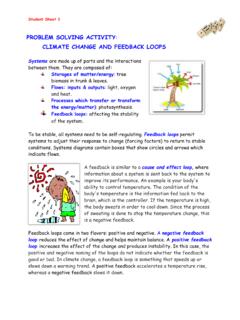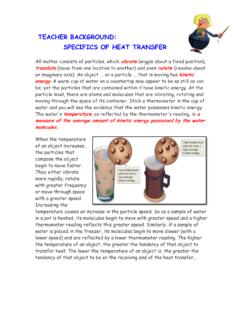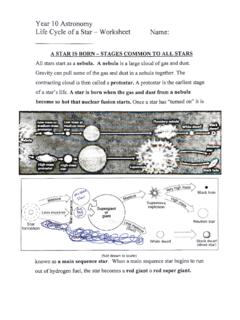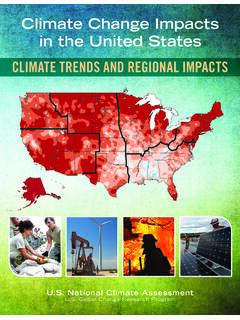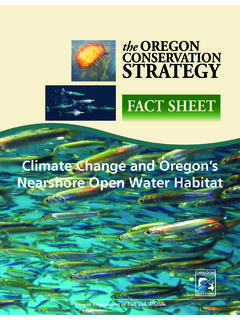Transcription of TEACHER BACKGROUND: NATURAL CLIMATE CHANGE
1 TEACHER BACKGROUND: NATURAL CLIMATE CHANGE . The NATURAL variability and the CLIMATE fluctuations of the CLIMATE system have always been part of the Earth's history. To understand CLIMATE CHANGE fully, the causes of CLIMATE CHANGE must be first identified. The earth's CLIMATE is influenced and changed through NATURAL causes like volcanic eruptions, ocean currents, the Earth's orbital changes, solar variations and internal variability. Volcanic eruptions - The main effect volcanoes have on the CLIMATE is short-term cooling.
2 Volcanic eruptions pump out clouds of dust and ash, which block out some sunlight. Because the ash particles are relatively heavy, they fall to the ground within about three months, so their cooling effect is very short-lived. But volcanic debris also includes sulfur dioxide. This gas combines with water vapor and dust in the atmosphere to form sulfate aerosols, which reflect sunlight away from the Earth's surface. These aerosols are lighter than ash particles and can remain in the atmosphere for a year or more. Their cooling effect outweighs the warming caused by volcanic greenhouse gases the eruption of Mount Pinatubo in 1991 caused a C drop in global temperature.
3 Volcanic eruptions spew out lava, carbon dioxide (CO2) ash and particles. Although CO2 has a warming effect, average volcanic CO2. emissions are less than 1% of emissions from current human activities..Large volumes of gases and ash can influence climatic patterns for years by increasing planetary reflectivity causing atmospheric cooling. Ocean currents - The oceans are a major component of the CLIMATE system. Ocean currents are located at the ocean surface and in deep water below 300 meters (984 feet). They can move water horizontally 1.
4 And vertically and occur on both local and global scales. The ocean has an interconnected current, or circulation, system powered by wind, tides, the Earth's rotation (Coriolis effect), the sun (solar energy), and water density differences. The topography and shape of ocean basins and nearby landmasses also influence ocean currents. Deep ocean currents are density-driven and differ from surface currents in scale, speed, and energy. Water density is affected by the temperature, salinity (saltiness), and depth of the water.
5 The colder and saltier the ocean water, the denser it is. The greater the density differences between different layers in the water column, the greater the mixing and circulation. Density differences in ocean water contribute to a global-scale circulation system, also called the global conveyor belt The global conveyor belt includes both surface and deep ocean currents that circulate the globe in a 1,000-year cycle. This circulation is the result of two simultaneous processes: warm surface currents carrying less dense water away from the Equator toward the poles, and cold deep ocean currents carrying denser water away from the poles toward the Equator.
6 The ocean's global circulation system plays a key role in distributing heat energy, regulating weather and CLIMATE , and cycling vital nutrients and gases. Earth orbital changes - Shifts and wobbles in the Earth's orbit can trigger changes in CLIMATE such as the beginning and end of ice ages. The last ice age ended about 12,000 years ago and the next cooling cycle may begin in about 30,000 years. But orbital changes are so gradual they're only noticeable over thousands of years not decades or centuries. The earth makes one full orbit around the sun each year.
7 It is tilted at an angle of to the perpendicular plane of its orbital path. Changes in the tilt of the earth can 2. lead to small but climatically important changes in the strength of the seasons , more tilt means warmer summers and colder winters; less tilt means cooler summers and milder winters. Slow changes in the Earth's orbit lead to small but climatically important changes in the strength of the seasons over tens of thousands of years. CLIMATE feedbacks amplify these small changes, thereby producing ice ages. Solar variations - The Sun is the source of energy for the Earth's CLIMATE system.
8 Although the Sun's energy output appears constant from an everyday point of view, small changes over an extended period of time can lead to CLIMATE changes. Some scientists suspect that a portion of the warming in the first half of the 20th century was due to an increase in the output of solar energy. As the sun is the fundamental source of energy that is instrumental in our CLIMATE system it would be reasonable to assume that changes in the sun's energy output would cause the CLIMATE to CHANGE . Scientific studies demonstrate that solar variations have performed a role in past CLIMATE changes.
9 For instance a decrease in solar activity was thought to have triggered the Little Ice Age between approximately 1650 and 1850, when Greenland was largely cut off by ice from 1410 to the 1720s and glaciers advanced in the Alps. Current global warming however cannot be explained by solar variations. Since 1750, the average amount of energy coming from the Sun either remained constant or increased slightly. If global warming was caused by a more active sun, scientists would expect to see warmer temperatures in all layers of the atmosphere.
10 They have only observed a cooling in the upper atmosphere, a warming at the surface and in the lower parts of the atmosphere. This is due to greenhouse gasses capturing heat in the lower atmosphere. Also CLIMATE models that include solar irradiance changes cannot reproduce last century's observed temperature trend without including a rise in greenhouse gases. 3. Internal variability- Some changes in CLIMATE have no external trigger. These changes are instead caused by interactions within the CLIMATE system itself, often involving positive feedbacks.

